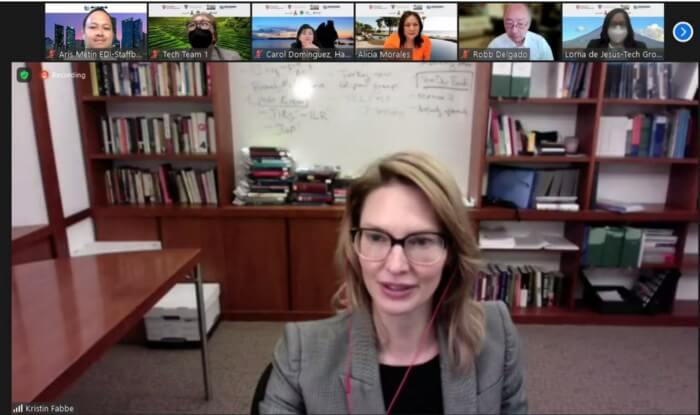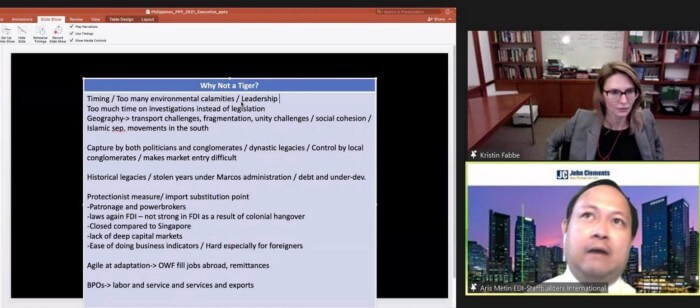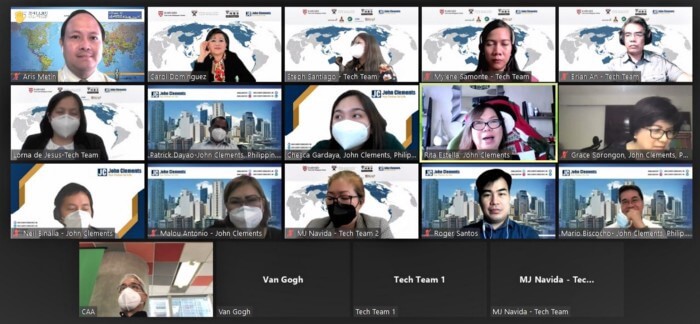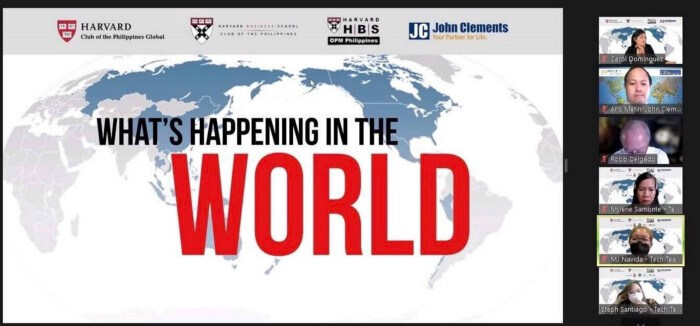When the Philippines was given independence by the Americans in 1946, the country was one of the most robust economies in Asia. The so-called Pearl of the Orient, the Philippine economy was vibrant and promising from 1950–65, exceeding that of neighboring countries such as South Korea and Taiwan, while Singapore was a struggling, swamp country back then. At some point during that era, the Philippines per capita income was second only to Japan — which meant that the Filipinos were once one of the richest populace in the world.
WHAT HAS HAPPENED?

To answer this profound question, Harvard University Professor Kristin Fabbe facilitated a virtual class discussion with more than eighty (80) participants from the USA, India, Australia, Thailand, Japan, Hong Kong, France, and the Philippines, last November 19th in a 3-day learning event dubbed “What’s Happening in the World?”, organized by John Clements Consultants in collaboration with the Harvard Business School Club of the Philippines, Harvard Club of the Philippines Global and HBS OPM Philippines. For three days, participants analyzed seven case studies on Singapore, China, India, Australia, Japan, the Philippines, and the U.S.A.
PHILIPPINE POLITICS
The Marcos Regime, 1965–1986
Ferdinand Marcos was propelled to the presidency by the public’s outrage over lack of development, growing corruption and slow growth. Marcos promised an export-led economy, land reform, stable finances, infrastructure projects, dismantling of oligarchy, and established foreign confidence, among others.
Marcos declared Martial Law in 1972 over growing unrest from certain segments of the society. The martial law years were mired in violence, accumulation of large foreign debts, corruption, and a balance of payments crisis which led to a declaration of payment moratorium of the Philippines’ foreign debt of US$ 26 billion.
The oil crisis in the late 1970s, high interest rates, and a recession brought more discontent to all levels of society, particularly the middle class. When Ninoy Aquino was assassinated in 1983, the international community lost its support for Marcos. Ferdinand Marcos, along with the First Family, was exiled to Hawaii. Today, the Marcos family is back in the Philippines holding executive and legislative positions, and Ferdinand Marcos’ only son, Bongbong, is campaigning for the presidency in 2022.
Corazon Aquino, 1986-1992
Corazon Aquino, widow of assassinated Senator Benigno Aquino, was the first woman-president of the Philippine republic. She was greeted with a country in deep debt, low investor confidence, a contracted Gross National Product, and mangled with graft and corruption.
Cory, as she was fondly called by supporters, enacted a new Constitution, eliminated monopolies, implemented privatization of government-owned enterprises or public utilities, restored investor confidence, and opened the Philippines to global trade.
However, poverty pervaded in the rural areas as it lacked development; land reform was not fully implemented and the country was facing a serious energy crisis.
Fidel Ramos, 1992–1998
The Defense Minister of Corazon Aquino, Fidel Valdez Ramos, became president. During the Ramos presidency, the Philippines slowly gained momentum for stable economic recovery. He promoted liberalization, foreign investments, and privatization. It was during his term that the Philippines joined the World Trade Organization, the only global international organization dealing with the rules of trade between nations. The WTO’s goal is to ensure that trade flows as smoothly, predictably and freely as possibly.
Macroeconomic indicators showed progress by the mid-1990s despite natural calamities. In 1997, the Asian Financial Crisis happened and the Philippines slumbered into recession.
Joseph Estrada, 1998–2001
Winning the elections with a landslide victory, Joseph Estrada’s governance was aimed at narrowing the Gini coefficient, or the income inequality between the rich and poor. Barely three years in office, Estrada was deposed by a series of events: an impeachment trial, a coup d’etat, widespread public protests and rioting.
Soon after, former President Estrada ran and won as mayor of Manila, the Philippines’ capital, and served two terms from 2013 to 2019.
Gloria Macapagal Arroyo, 2001–2010
Replacing deposed President Estrada, Vice President Gloria Arroyo took the helm. Under the Arroyo administration, economic growth averaged 4.5%, the peso appreciated, inflation was reduced to 2.5%, and the Gross Domestic Product (GDP) was at 3.6%. The Arroyo presidency was legitimized by the 2014 national elections (although mired in alleged electoral cheating) and the Philippines, with a steady economic performance, was back on the map of emerging economies. Still, graft and corruption plagued the country and the Philippines fell into an economic crisis.
Former President Macapagal Arroyo consequently served as representative of the second district of Pampanga in Congress since 2010.
THE PHILIPPINES: THE IMMEDIATE THEN AND NOW
Benigno Simeon Aquino, 2010–2016
Winning an overwhelming victory during the 2010 elections, President Aquino had a clear strategy on where to bring the country. Nicknamed Noynoy, his administration aimed to bring foreign direct investments, and prudent fiscal and monetary policies — which some critics viewed as overly prudent as there were delays in implementing infrastructure projects, among others.
Under the Aquino administration, revenue collections grew by 13.7% of GDP; FDI from 2.7 to a high of 6.8 in 2014; and a Current Account Balance averaging at 8.2 from 2010 to 2015. The Philippines received its first-ever investment-grade credit rating of BBB- by Fitch. A BBB+ rating meant an obligor has adequate capacity to meet its financial commitments.
Rodrigo Duterte, 2016 to present
President Rodrigo Roa Duterte holds the distinction of being the first president hailing from Mindanao, and the first mayor to have reached the topmost position in the country in one try. Popular, with solid support from the grassroots, Duterte still enjoys very high satisfaction ratings in recent surveys as he serves the remaining months of his presidency.
Under Duterte, poverty alleviation programs and infrastructure projects flourished. His war on drugs reduced crime to more than fifty percent. Economically, the Philippines was among the fastest-growing economies in 2016, growing at 6.8% and surpassing other ASEAN countries. Infrastructure projects were allotted 5–7% of GDP.
WHY IS THE PHILIPPINES NOT (YET) AN ECONOMIC TIGER?

Harvard University Professor Kristin Fabbe raised this question and generated responses from the class, to wit:
- Geography — transportation challenges, fragmentation, unity challenges, lack of social cohesion, religion
- Historical Legacies — debt, underdevelopment, graft and corruption in government
- Too many environmental and natural calamities
- Lack of deep Capital Markets
- Ease of Doing Business — hard especially to foreigners
- Not strong in Foreign Direct Investment due to Protectionism or as a result of colonial hangover
- Incohesive Infrastructure
- Dependency on OFW Remittances, BPO services
- Dynasties — control by politicians
- Conglomerates which make entry-to-market difficult
- Leadership — the lack of.
On the other hand, Professor Fabbe asked what the next government administration should focus on so that the Philippines becomes an economic Tiger. The class presented some ideas such as:
- Leadership — honest, respectable, intelligent, experienced
- Government officials, Cabinet and Economic Team — based on meritocracy, patriotic, high integrity
- Continuity of Policies and Structural Reforms
- Tax System Reforms to broaden the consumption base
- Improve the ease of doing business by eliminating barriers
- Poverty alleviation
- Rebound from the economic devastation of COVID-19
- Strengthen the Healthcare system
- Internet and Telecommunications
- Build-Build-Build Programs — continuity and completion of infrastructure projects
- Defend Philippine sovereignty
- Unite the country
INTERESTING TRENDS

In closing, Prof. Fabbe shared interesting economic indicators before the COVID-19 pandemic which can serve as buoyant forces for recovery or pre-emptive insights that can help navigate the immediate future:
- Prior to the pandemic the country was performing well, with a 2017–2019 average real growth of 6.6%
- In 2020, Real GDP decreased by 9.6%
- The large recession in 2020 lowered potential output through the sharp decline in investment (-27%) and the high unemployment rate (10.4%)
- Potential output growth is expected to remain low due to the structural changes triggered by the pandemic.
- Containment policies led to a sharp drop in domestic demand in the country compared to other emerging markets or ASEAN peers.
- Inflation started to increase, mainly due to transportation bottlenecks and food supply shocks.
- Prudent fiscal management prior to the pandemic provided the Philippines with substantial fiscal space to respond to the pandemic.
- The fiscal deficit nearly doubled in 2020, in part due to the authorities’ fiscal response to support recovery during the COVID-19 pandemic.
- With a sluggish recovery in revenue and the continued need for fiscal support, the general government debt-to-GDP is expected to peak at about 62% in 2024.
- The country has experienced large swings in its current account balance in the past decade. These fluctuations are mainly explained by the widening and narrowing deficits for trade in goods.
- The balances in other accounts (services, primary and secondary income) changed relatively little.
- The current account balance is expected to return to a deficit in the medium term due to rekindling investments.

The upcoming national elections, highlighted by one the participants in the virtual class, “is very crucial and critical to national interest. It will define how the Philippines will navigate the next decade; to handle the current situation and recover from the COVID-19 pandemic; to maneuver the country from poverty and disunity; to propel or pivot the Philippines simultaneously to global recovery. More strategically, how to align with the powerhouses of the world — will it be the US or will it be China? Or will the Philippines aspire for self-reliance?”
The Philippines, regardless, will still be a natural participant or casualty in this geo-politics. Our next generation’s fate and future is at stake.
Please visit and join the John Clements Talent Community.
References:
Kristin E. Fabbe Professor Fabbe’s research interests center on modernization, identity politics, social resilience and cohesion… www.hbs.edu
Philippines: From Sick Man to Strong Man, HBS Case N9–717–058 by Dmeg Rithmire and Dawn H. Lau




